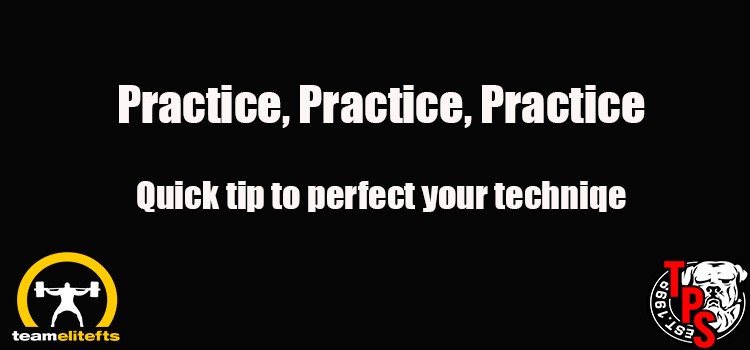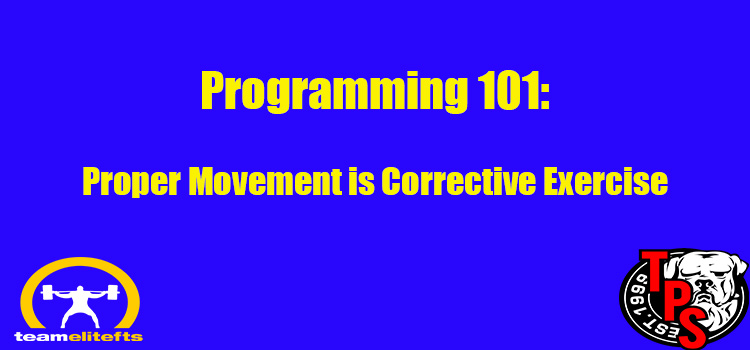
I hope that you are enjoying my series on Programming 101.
You can review installment 1-4 below if you missed them.
Today’s installment is on corrective exercise and when to apply it and is like a Part 2 of a log I wrote a few weeks ago.
Before we go into that we must understand that corrective exercise is not needed as much as it is bandied about on the internet today.
Yes, sometimes corrective exercise is required but before we get into specialty exercises, we, as coaches need to figure out if the movement patterns that we are asking clients to perform are correct, and if they are not, why?
I see poor movement just about every day at TPS.
Sometimes it is with members training on their own, and sometimes it is with our clients.
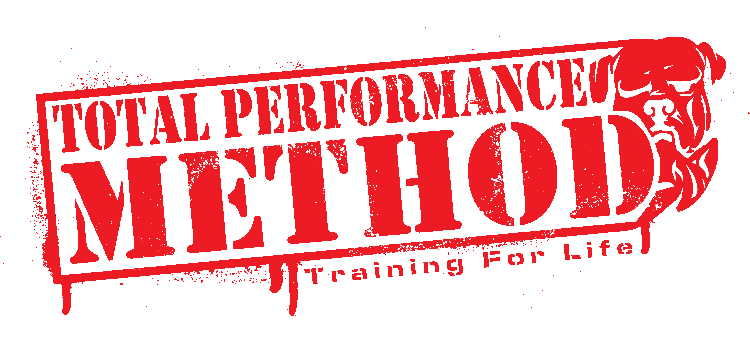
We run a group strength training program called the TPS Method and it has a lot of people in it, so we see a huge sample of the population, and we use it as a laboratory on how to train people to be their best.
In the TPS Method we coach people from diverse fitness backgrounds including (but not limited to):
- obese people who have never exercised
- returning to exercise after a layoff, such as a few years after college
- returning to exercise/referred to us from Physical Therapy
- people with lots of mobility issues from lifestyle/work environment
- those with no issues who have been training and want something different
- athletes
Some of them can just get in the program and get after it.
Some need to be regressed until they can handle higher levels of training.
Some can’t even handle the regressions.
Let’s talk about the ones who can’t just jump in.
A little background on how we do things is in order first so you can get an understanding of what is going on.
Our program is based on Strength first.
Everything is built off of that as you all know.
In order to get strong, you must be able to move properly or an injury will occur.
While many lifters don’t care about that, the general population does. They can’t be banged up because they have to go to work, so we must be smart.
The program is based on 7 Foundation Exercises:
- Squat
- Press
- Deadlift
- Kettlebell Swing
- Pushup
- Plank
- Turkish Get Up
These are all basic human movements and when performed properly, they will improve strength, GPP, mobility and flexibility.
This exemplifies Proper Movement is Corrective Exercise.
You can’t do these exercises well with bad motor patterns.
That seems like a winner to me for the general fitness population.
We make every person go through an 8-week Beginner phase where they are taught several things:
- Proper Warmup including RPR
- Rooting
- Bracing
- Mastery of body weight before moving on to more advanced exercises
We use an introduction to basic barbell lifts through a systematic, methodical approach that covers all aspects of the lift including setting up on the bar, walkout, rooting & bracing, execution of the lift, re-racking the weight.
For those who have been training and do it well, this is a deload period where we integrate them into our style of training.
An Acclimation Block if you will.
For those who have not been training, this 8-week period allows us to identify bad movement, identify flexibility/mobility issues, correct those as best as we can, and get them progressed as soon as they can to the main Foundation lifts.
Let’s review an example client.
We have a 45-year-old male, average height, weight with no injuries. He used to play sports in high school and college, but hasn’t done much since, and he sits in traffic on the way to work for 45 minutes of more each way daily, and then rides a desk for 8 hours.
You should already assume a few things:
- Tight hamstrings & hips
- Weak torso
- Chest breather
- Internally rotated shoulders, probably with tight pecs and a weak upper back
This is a go to list for a huge percentage of the commuting/office work population.
Looking at how we do things, our warm up will help to correct all of this immediately through dynamic movements paired with RPR.
Once we get through the warm up, we cover rooting and bracing in depth.
Rooting is key as I am a FIRM believer that the feet control everything up the chain.
Mike Boyle’s Joint by Joint approach is a good example of this, but we focus heavily on the feet because if they are off, all of the joints above will be off at some point.
After rooting and bracing we move them to Squats on Day 1.
We teach them to Wall Squat, and then move to a Goblet Squat on a box, or free.
As Active Rest we teach them to approach the Squat bar, take a proper grip, unrack it, walk it out and then root and brace.
In this sequence we stress proper hand position on the bar too.
Many times we will have a person, and I will use this guy as an example, who cannot hold the bar properly. They can’t get their hands in a good spot due to inflexibility in the shoulder girdle.
If they can’t get a proper grip on the bar, how can we expect them to Squat correctly?
So, instead of making them Squat with a bar poorly, we have them learn the Squat pattern with a Goblet Squat, and then go back to the rack/unrack sequence.
In the old days I'd just have them Safety Bar Squat, but that was then and I know more now. This doesn't do anything to FIX THE PROBLEM.
I will frequently have them do some extra RPR on the shoulder series in between sets, and I’ll pull out my favorite tool to get immediate results, the Acumobilty balls.
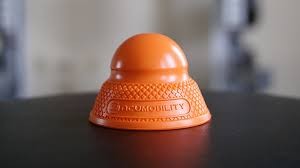
I have found that hitting Acumobility upper back, pec and mid back releases greatly improves the ability to get the hands in the correct position on the bar on Day 1.
As we move on, we also frequently see people who simply cannot get proper depth in the Squat pattern.
I could suggest Corrective Exercises, but I usually don’t.
Remember, Proper Movement is Corrective Exercise, I like to get them moving better before doing anything else.
Hip mobility is a huge factor in getting depth, not the only one, but lets assume it is the case here.
I can have them stretch and do Correctives, but as I said, why?
I’ll go right back to the Acumobility balls and teach them to release the Psoas.
Almost to a person, we see the combination of upper/mid back/pec releases paired with the Psoas release gets them to depth, or almost on the first day.
As a coach you have to understand movement and how to identify the causes of the faults in it. Learn to assess, identify and correct it quickly.
Here’s another example, I see people almost daily whose knees cave in on the squat.
Many of you will think they need to do more work to strengthen the external rotators of the hip and suggest sitting on a box and doing Bad Girls with a band three times a week to help this.
While this may help, I’d suggest that you closely watch them squat and start at their feet as they do a rep.
Watch the feet, watch the knees and hips, watch the torso and upper body too.
Be a coach, not a trainer.
I’ll bet that 9 times out of ten, the feet are shifting inwards as the get closer to depth and this is causing the valgus (cave in of the knees).
Try stopping them and correct the movement. Tell them or physically show them to ROOT during the entire rep. This may fix it. If it doesn’t, it will IMPROVE it. That’s a win.
You aren’t going to fix problems that took years to accrue in one session, but an improvement is a win.
I will usually advise an internal rotation stretch for the hip in between sets for 15 seconds per side in this case.
Almost to the person, again, when they go to their next set, it improves.
Why?
Well, the feet are more active because you made them aware, and you addressed that cause of the problem, which was not rooting and tight hip structure.
No, what I did here will not fix everything, but in this case it did, and it does a lot. I do this daily with success.
Every person will have their own unique issues, but most will all have similar ones (listed above).
Learn to assess, identify and correct all of the lifts that you are coaching. Make sure you know all of the most common faults in each lift and what causes them. If you know what causes them, you’ll know how to fix them.
Sometimes it IS a weak muscle group that need to be made stronger, but I see this less with the general population, and more with lifters. EG: Weak triceps affecting bench lockout
If you suspect a weak muscle group, I’d suggest monitoring the lift showing a fault closely and making sure their positions are correct and they have they required mobility to perform it AS WELL as the rooting and bracing.
I haven’t covered bracing much here, because I see most flaws come from the feet first, but improver bracing is also a major cause of faults.
As you watch your client (or yourself on video) execute the lift, do they have the required mobility to perform it well?
If they don’t, fix the movement before suggesting corrective exercise to strengthen what you suspect is weak.
If you don’t, you might make the issue worse. When movement is poor, compensation results, when compensation is in place, injury usually occurs at some point.
Let’s look at the Press using the same guy from above.
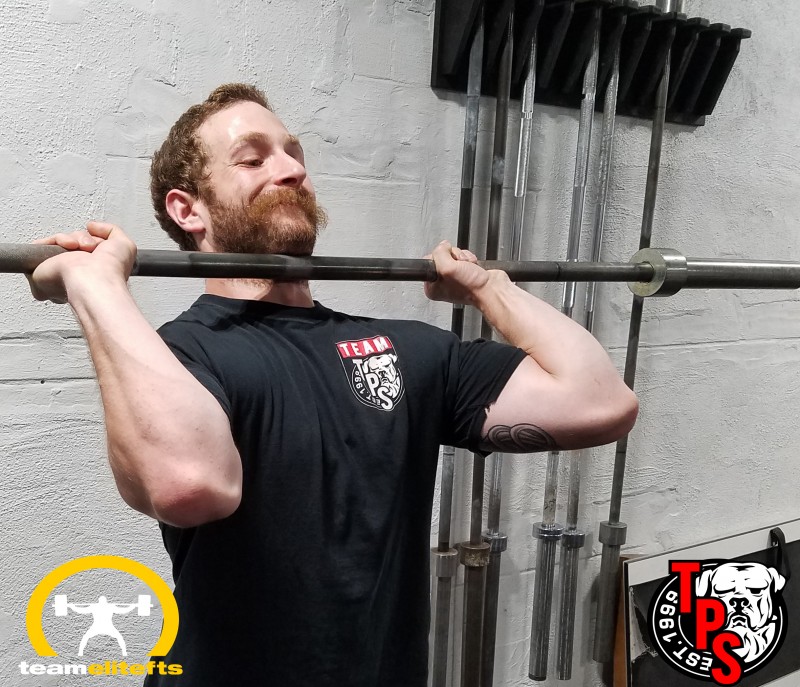
Nice Rack
We already know that he lacks flexibility in the pecs and has weak upper back, both of these will cause major issues in the set up for the press.
When we press the barbell, we must have the shoulders forward, the elbows pushed up and out and as high as possible as shown in the photo.
Please don’t be the guy pressing with your arms starting at 90 degrees from the floor……
At the completion of the press, the bar MUST be overhead inline with the center of the body and the head and shoulder girdle pushed through, with the hips thrust back.
There is no way our guy from above can do this, so we regress.
Teach the rack, walkout and set up and observe what you see. Don’t let them press if the rack position is poor.
Instead, do some RPR for lats and shoulders, and grab your trusty Acumobility balls and pec release, maybe a tricep stretch and then go at it again.
If you see an improvement in movement, no correctives are required.
Get it?
When are correctives required?
I generally don’t suggest corrective strengthening exercises until we attain proper movement with a lighter load.
Why?
Well, unless you see a ridiculous weakness or fault, it is probably unnecessary.
They just need to get stronger and learn the technique.
Once they have a decent understanding of technique and faults occur, then we may suggest correctives.
The upper back seems to be a pretty common weakness in many. A weak upper back can cause a lot of faults in the Squat, Deadlift, Bench Press and Pushup.
If you see this, go ahead and feel free to suggest extra work on off days or at the end of a session, or even as a warmup.
3 sets of 10-15 Face Pulls before a session should not interfere with their ability to train. It also will help in the long term.
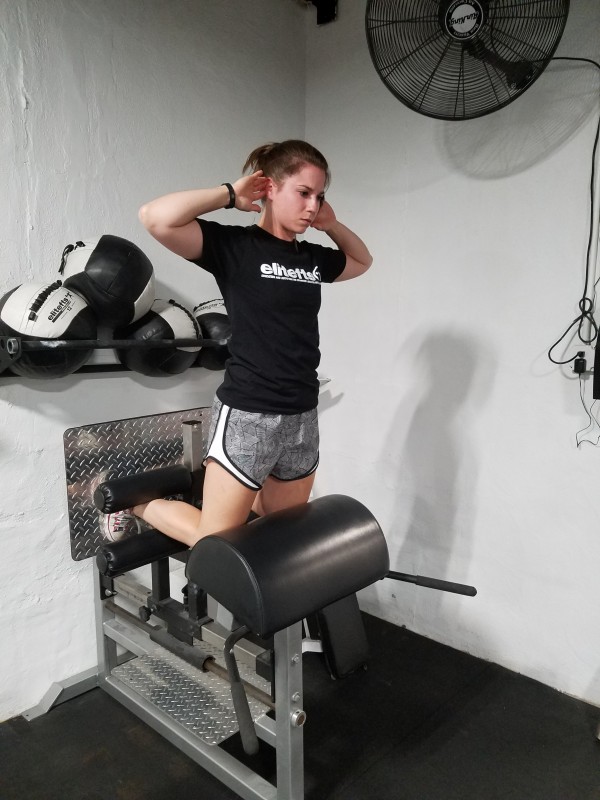
I also frequently suggest Glute Ham Raises to people. Most people are not overly strong in this area and getting it strong(er) will pay off in spades. (Old Timey reference)
As you may recall, I suggest doing a predetermined number of reps in the least amount of set possible in this instance. Usually before the actual training session as part of the warm up.
Try having them add in 25 GHR’s the first week in as few sets as possible if they can only do a few reps.
Progress like this:
- Week 1: 25 reps
- Week 2: 35 reps
- Week 3: 45 reps
- Week 4: 30 reps
You can choose whatever reps you feel are required but less than 25 probably will no do much.
This can be done with a lot of exercises, and I have used a circuit of:
- GHR
- Fat Guy Pullups
- Pushups
I've been using this as a corrective/GPP builder for years.
And it has not negatively affected one person’s ability to perform their training session, as a matter of fact, most say they perform better as a result.
To sum up:
- Sometimes you need to program corrective exercises.
- Most time you don’t.
- Most times you need to correct movement. Correcting movement by ensuring proper bracing and rooting is first. Adding in well chosen flexibility/mobility drills is second.
- If this doesn’t improve it (not fix it), then you may have to go further with corrective strengthening exercises.
- Don’t add in correctives until they have some mastery of the movements.
- Sometimes the best corrective is to improve strength and GPP. This will lead to better technique too.
- Simply dragging, pushing, pressing and rowing a sled for 15 or 20 minutes on off days does this quickly.
- Sometimes the addition of GHR’s, pushups, and Fat Guy Pullups does it too.
- Sometimes using both works faster, and it gets them in the gym an extra two days yielding faster overall results for them, and making your program work better.
There are a lot of great sites out there from quality coaches with corrective exercises on them. Fire up your Google machine and find the good ones.
I’ll be launching Tpsmethod.com in a few months that will have this and much more.
Did you miss my last coaching log?
Find me on Google-search for Total Performance Sports Malden, Mass. The Best Gym in Boston, Facebook too.
Oh, yeah, follow us on Instagram too. TPSMalden
SHARE THIS!
#bostonsstrongest
Vincere vel mori
By: C.J. Murphy
July 5, 2018









